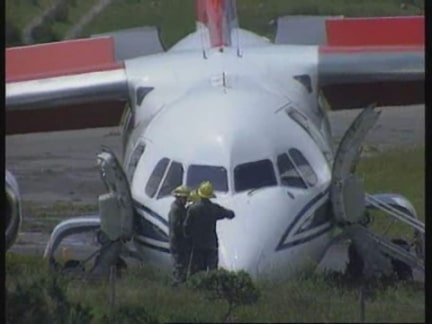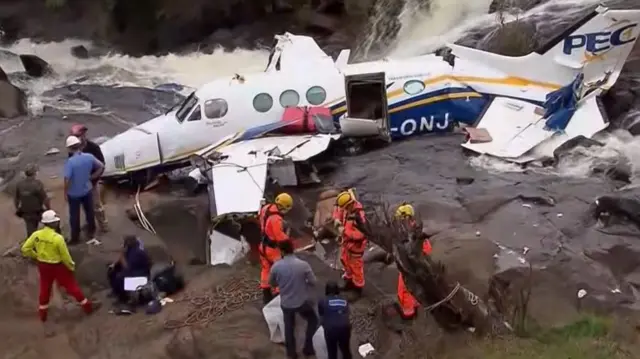Adverts
It is inevitable that, when stepping on a plane, many of us have asked ourselves: “What should I do if something goes seriously wrong during the flight?”
Are you afraid of flying on a plane?
What makes you most nervous during a flight?
Have you ever had any stressful experiences during landing?
Does your heart race when the plane starts to roll down the runway?
Have you ever thought about giving up on a trip because of your fear of flying?
This question may seem dramatic, but the truth is that plane crashes, although rare, can happen. And in extreme situations, it is our ability to maintain control that makes all the difference.
Adverts
The focus here is not to spread panic, but rather to explore practical survival tips in possible emergency scenarios, especially during a plane crash. After all, understanding a few simple procedures can considerably increase your chances of emerging unscathed from a highly unlikely but tremendously impactful event when it does occur.

It’s fair to say that no one gets on an aircraft expecting to be involved in a disaster. However, understanding safety protocols and knowing what to do in a moment of panic can save lives.
Adverts
From learning how to adopt the correct brace posture to knowing when (and how) to get up from your seat, every detail can be crucial.
And it doesn't stop there: maintaining mental clarity during severe turbulence or mechanical failure requires an extra dose of self-control. But believe me, our body is prepared to react in surprising ways, even in the midst of chaos.
Next, we’ll dive into strategies that can help you stay calm, help those around you, and still make better decisions.
Recommended Articles:

How to Stay Focused in the Midst of Chaos
Our instincts are powerful allies, but we need to know how to use them at the right time. When we are in a panic, we tend to act on impulse or even freeze. Imagine the scene: the plane starts to shake, the oxygen masks fall from the ceiling and the emergency lights flash non-stop ⚠️. This type of situation, as distant as it may seem from our daily lives, is always good to keep in mind. Preventing despair involves knowing the basic safety measures offered by airlines and also developing a strong mental attitude. And this mental attitude does not appear out of nowhere; it comes from training, information and calm.
One of the essential points for maintaining emotional balance is understanding why each safety procedure exists. When the crew asks you to buckle up or adopt a certain posture, there is a technical reason behind these instructions. Throughout the text, we will explain how the position of your legs, arms and even your head can help minimize impacts. We will also address the importance of being aware of the exact location of the emergency exits, as this makes all the difference in escaping quickly if necessary. Knowing the environment you are in, even if only briefly, increases your situational awareness and reduces panic.
In addition, we will explore the importance of following flight attendants' instructions (without hesitation) and understanding audio and visual signals inside the aircraft. When it comes to plane crashes, seconds can determine who walks away and who is left behind. And speaking of time, it is crucial that you know how to react when each fraction of a second seems to last an eternity. With some breathing and concentration techniques, it is possible to regain some internal control, reducing the paralyzing effects of fear. After all, it is normal to feel your heart racing, your legs shaking and a flood of negative thoughts. The difference lies in the ability to turn this wave of anxiety into coordinated actions.
Another issue involved in extreme situations is how we deal with the people around us. In a scenario of collective panic, each individual reacts in a different way: some scream, others pray, some go into shock 😰. Having empathy and, at the same time, maintaining self-awareness can be the key to positively influencing those around you. You will see that, in the following topics, we will cover everything from the best posture for moments of greatest impact to the importance of acting as a group and identifying warning signs on the flight. We will also talk about smart choices when every move matters, such as evaluating whether you should remain seated or quickly get out of your seat.
We’ll cover the oversight of flight attendants, the support of military professionals, and the lessons learned from survivors of major plane crashes. There’s no one-size-fits-all answer—every situation presents unforeseen variables, such as the exact location of impact, the type of terrain, or the weather conditions. However, there are a set of universal guidelines that can significantly increase your chances of coming out of this devastating experience with as little damage as possible. From how to pack your carry-on bag to choosing the right footwear for travel, nothing goes unnoticed when your goal is to survive the unlikely.
In this comprehensive, three-thousand-word article, you will find details on how to manage fear, what body position to assume, and what concrete steps to take to protect your physical integrity. We will cover survival concepts used in pilot and special forces training, adapted to the reality of ordinary passengers. By the end, you will not only be more aware of how to react during a plane crash, but you will also have insights that can be applied to other intense crises. Emergencies, whether on the ground or in the air, require a quick and pragmatic response.
Stop thinking that this type of information brings bad luck or that it is not relevant to your daily life. Talking about “what to do during a plane crash” may sound disturbing, but believe me: knowing what to do in these extreme moments brings a sense of preparation that at least partially eliminates that irrational fear of flying. It is obvious that no one wants to have to use this knowledge, but it can be the difference between simply panicking or actually making decisions that preserve your life. So, let's dive into these details and understand that, even in the worst circumstances, there is still room for mental clarity, courage and attitude. ✈️

The Reality Behind Air Accidents: Statistics and Risk Factors
Hey, everyone! This is Pedro Henrique speaking, and today's topic is heavy, but super important: how to prepare for something we don't even like to imagine, like a plane crash. It sounds like something out of a movie, but the truth is that, although plane crashes are rare, when they happen, they attract a lot of attention and cause fear in everyone. The fact is that, in most cases, flying by plane is safer than driving a car. Statistics confirm that commercial aviation is currently one of the means of transport with the lowest fatality rate. For example, according to annual reports from international aviation organizations, the probability of a commercial flight suffering a major accident is extremely low, about 1 in a million. Even so, for those who get on a plane, the fear of a plane crash can be enormous, because even a little turbulence can make many people's hair stand on end!
The problem is that even these reassuring numbers do not take away from the fact that, in specific cases, plane crashes do happen. Many of them involve factors such as human error, mechanical failures, adverse weather conditions or even air traffic control errors. It is a complex combination of situations in which every detail makes a difference. Many accident investigations identify chain events – one problem leading to another, resulting in critical incidents. Therefore, being aware of everything that happens during a flight and understanding to what extent we have some control can help us feel less powerless.
But there’s no denying that everything related to aviation arouses curiosity and nervousness, right? Often, the tension starts at boarding, when we go through the whole check-in ritual, takeoff and even that unexpected “fastening of seatbelts” in the middle of turbulence. So, thinking about surviving a plane crash is not an exaggeration: it’s a way of dealing with a scenario that, however unlikely it may be, can be crucial if it happens. And, if we analyze the history of aviation, we see that there are several examples of survivors who managed to get out of extreme situations using technique, knowledge and, of course, a good dose of composure. The idea here is not to create panic, but to provide valuable information to prepare you for the unimaginable. And preparation begins with understanding what the most common risk factors are and how statistics can help you see that, often, “feeling safe” also involves understanding that risks exist, but can be mitigated. Do you know when you’re on a plane and you hear the safety instructions? Many people ignore it, but this is the gateway to doing well in the future, if something goes wrong. Let's see what else is important?
Pre-Shipment Preparation: How to Anticipate and Minimize Risks
Now that we know that plane crashes, although rare, can happen, it’s time to talk about something that not everyone thinks about: how to prepare before even stepping on a plane. Many people think that safety begins and ends with wearing a seatbelt, but the truth is that there are several decisions you can make before boarding, in which small actions can have a huge impact. For example, choosing a flight with a reliable and well-reviewed airline is one step. If you can check the maintenance history, whether the company has a good reputation, whether there are reports of frequent delays or cancellations due to mechanical problems, all of this helps to build a more consistent safety picture. Of course, we don’t always have the freedom to choose the ideal airline – discounted tickets, specific dates and other factors end up influencing – but, whenever possible, investing in companies known for their reliability can be a good idea.
Another important tip is to check your own health before traveling, as feeling unwell can disrupt the smoothness of your flight. Have you ever imagined feeling sick on a plane due to a lack of medication or having ingested something that made you sick at the airport? In an extreme scenario, any symptoms can get worse in a pressurized cabin. So, if you have any medical conditions, it is crucial to carry medication in your carry-on luggage and inform the crew or ground staff if you need any support. In addition, it is a good idea to eat a light diet before the flight, drink water to stay hydrated and try to organize yourself so that you do not board the plane out of breath and full of stress. Stress itself can be a trigger for anxiety and, consequently, can impair your reaction in emergency situations.
Regarding the choice of seat on the plane, this is also a decision that can, in certain cases, increase your chances of survival if an incident actually occurs. Many statistics indicate that, depending on the type of accident, seats close to emergency exits or located at the back of the plane have slightly higher survival rates. Of course, this is an estimate, and each case is different. Even so, if you have this possibility, checking the following table can help you make a more targeted decision (see the table below):
| Seat Location | Advantages | Disadvantages |
|---|---|---|
| Near the Emergency Exit | Greater chance of quick evacuation, more legroom | Responsibility to assist in case of emergency, may receive additional instructions |
| Front | Faster landing and less turbine noise | Survival statistics vary, in the case of a frontal collision they may be more critical |
| Back | Some studies indicate slightly higher survival rates | More turbulence, more noise |
When we talk about preparation, we can also include mental attitude. We don’t always realize it, but traveling by plane can cause anxiety to the point where a person loses their rational sense during an emergency. So, I always advise: study the emergency exit map, pay attention to the flight attendants’ briefing, notice where the life jacket is and how to use the oxygen mask correctly. It seems basic, but in a moment of panic, our brain tends to go into “survival” mode and forget simple steps. If you’ve already heard, reviewed and understood, your chances of acting quickly increase. In short, preparing yourself before boarding means thinking about the flight as something that requires a minimum of planning. These are simple steps that, when taken together, can greatly increase your safety and peace of mind on board.

Safety Strategies: What to Do During a Plane Crash
This is undoubtedly the most terrifying moment. You are on a flight and suddenly you realize that something is going very wrong: severe turbulence, an unusual metallic noise or, in extreme cases, the crew announces that there is a serious problem. At this point, your heart starts racing and the atmosphere can become chaotic. But keeping a cool head is essential. If you already have some safety strategies in mind, the chances of being able to react more efficiently increase exponentially. The first step is to listen to the instructions of the flight attendants, as they are trained to deal with emergencies. If they tell you to buckle your seatbelt, put your head between your knees or adopt the famous “brace position” (impact position), do it immediately. Some people’s instinct is to jump out of their seats or run aimlessly, but this only complicates things.
Brace position is a simple but important concept. If you are in a front seat with plenty of room, you should rest your head against the seat in front of you and place your hands behind your head or on top of the seat to protect your skull. If there is not as much room, you should lean your torso forward as far as possible, placing your hands on your head with your elbows facing inward to protect your face. This position helps absorb the impact of falls or emergency landings, reducing the likelihood of serious head and spine injuries. The exact position may vary depending on the distance from the seat in front or the amount of space available, but the essence is to keep your body in a position that protects your head, neck, and spine.
Another strategy that experts often talk about is keeping your seatbelt fastened at all times while you’re seated. We know how tempting it is to loosen your seatbelt to stretch your legs or go to the bathroom more freely, but severe turbulence can happen without warning, and a simple “jerk” in the air can throw you to the ceiling of the cabin if you’re not wearing a seatbelt. In a sudden fall or loss of altitude, staying strapped into your seat greatly reduces the chances of injury due to impacts inside the aircraft. A little tip that can save lives is to pay attention to the “fasten seatbelt” lights: if it comes on, it’s time to make sure you’re safe in your seat. Even if there’s no warning, keeping your seatbelt loosely fastened – without tightening it too much – is a smart choice. It’s the old adage: prevention is better than cure, and in the case of a plane crash, every second and every detail makes a difference.
Keeping Calm in Extreme Situations
Staying calm when you’re facing an emergency in the air sounds almost impossible, but there are techniques that can help. Psychology shows that controlling your breathing is the first step to bringing your brain back to a rational state. If you find yourself panicking, try the following exercise: take a deep breath through your nose for 4 seconds, hold it for 2 seconds, and then slowly exhale through your mouth for 6 seconds (4-2-6). Repeating this process a few times can help reduce anxiety. It’s a bit hard to do this when everything around you is crazy, but try it: if you stay centered, even time seems to slow down. In this state, you can remember what you’ve learned, follow safety guidelines, and act more logically.
Another tactic is to focus on immediate actions, paying attention to sounds and instructions. Many rescue professionals advocate that having a purpose in the moment can keep your mind active and prevent mental breakdown. For example, it could be “I need to reach the emergency exit” or “I will hold onto my seat until the plane comes to a complete stop.” This mindset of small, sequential goals helps the person not sink into a loop of despair. If you have family or friends on board, try to instruct them and stay together if possible, as this increases the sense of safety. But be careful: if contact with them puts you at greater risk, such as walking through flames or heavy smoke, remember that the priority is to ensure your safety and follow the instructions of the flight crew, who can then orchestrate rescues and mutual aid.
I know it’s easier said than done, but practicing calm in mental simulations can be good “training.” Just as some athletes visualize the race before competing, you can, at home, imagine turbulent scenarios and see yourself using breathing techniques. It may seem silly, but this conditions the brain to, at the very least, recognize what to do if things get really tough. After all, many people don’t know, but there are several reports of survivors who mention having felt time “slow down” because they knew, through some previous training or repeated guidance, what they needed to do next. And, when you think about survival, every fraction of a second used in the right way is worth its weight in gold. So
Conclusion
We have reached the final moment of this content, and there is nothing better than recapping everything we have seen in a clear and relaxed manner, to further reinforce the importance of each detail explored throughout the article. So, sit back and let's go on this journey of closure, revisiting the main points and reflecting on how all of this connects to our routine and our cultural and technological interests. It is always wonderful to realize how, when we combine quality information with a touch of lightness, we are able to expand our horizons and feel motivated to share our learning with the world 🌎.
At the beginning of the article, we discussed how technology has revolutionized the way we communicate, consume entertainment and even work on a daily basis. One of the main focuses was to observe how technological advances have made it possible to create connections that were seemingly unthinkable in the not-so-distant past, bringing people and segments of society together who were previously isolated. The growth of social networks, for example, has allowed artists and fans to communicate in real time, generating new opportunities for collaboration and, most importantly, fostering a globalized culture. This transversal characteristic is what makes different sectors – such as games, cinema and music – communicate with each other, creating unique trends that mark entire eras.
Next, we analyze how pop culture has been shaped by these innovations. We talk about the power of streaming services and the versatility of the internet for creating content. Remember when we talked about how certain video platforms, podcasts, and even music apps have gained millions of subscribers in a very short space of time? These tools have become powerful because they allow people to consume entertainment in a variety of ways, regardless of where they are. It’s incredible to see how this process has democratized access to movies, series, anime, and music albums. In addition, we address the active participation of fans, who now have a voice in the construction of the narrative of their favorite franchises, ceasing to be mere spectators and becoming part of the “lore” of these beloved universes.
Furthermore, a notable point was the analysis of the impact of e-sports, showing how electronic gaming championships have ceased to be niche and have gained national and international audiences. Competitions in League of Legends, Counter-Strike, Valorant and many others have reached gigantic proportions, even rivaling traditional sports in terms of audience and engagement. We discussed the importance of sponsorships, professional teams and the emergence of entirely new careers, such as e-sports narrators and commentators. All of this reinforces the idea that, in the digital age, any passion can find room to grow, as long as it is well planned and publicized.
Another point worth highlighting in the article was the relationship between nostalgia and innovation. We mentioned how new technologies have rekindled interest in old franchises, providing remakes, remasters, and even expanded universes that unite different generations. Who would have thought that series from decades ago would gain new life on streaming platforms? Or that classic console games would have modernized versions, bringing in not only veterans, but also curious younger fans🌟? This phenomenon reveals how the past and the future can coexist harmoniously when there is a good balance between tradition and the ability to reinvent the narrative.
We also talked about the growing importance of diversity and representation in pop culture, driven by discussions that are gaining increasing visibility on the internet. Whether in superhero movies, science fiction plots or game releases, there is an ongoing movement to better reflect the plurality of voices in our society. Characters that were previously neglected now occupy leading positions, and fans feel genuinely represented when they see their stories and personal characteristics highlighted. It is a process that still has a long way to go, but it is undeniable how much technology helps to give a voice to groups that were previously silenced, promoting exchanges and debates that enrich the cultural scene as a whole.
On a more practical note, we highlighted the importance of digital marketing and online engagement for brands and content creators. We analyzed how essential it is to establish a presence on social media, maintaining a close dialogue with the public and understanding that, nowadays, people want much more than just to consume products: they seek identification, stories and added value. From this perspective, we saw that strategies such as storytelling and the production of interactive content can create lasting relationships with the audience, winning loyal fans and transforming a project into something truly memorable. Whether on Instagram, TikTok or YouTube, the goal is always to convey authenticity and transparency to generate empathy.
Another very interesting aspect that we covered was the awareness of ethical and sustainable issues in the use of technology. Yes, we began to better understand the need to give due value to the correct disposal of electronics, the origin of components and the way companies handle user data. The legitimization of initiatives aimed at cleaner production, waste reduction and the protection of our privacy went hand in hand, showing that it is not enough to evolve technologically; we must do this journey responsibly, including the consumer in the process of building a fairer society. As a result, several brands and investors began to pay closer attention to innovations that reconcile profit and positive impacts on the environment.
We also revisited the professions of the future and how new generations are preparing for an increasingly dynamic job market. We mentioned that some current careers did not even exist a few years ago, while others that were dominant have undergone profound transformations or lost relevance. This constant adaptation reflects the rapid nature with which innovations occur. To deal with this, we emphasize the importance of staying up to date through online courses, specialized readings and networking on networks such as LinkedIn. And, if anyone still doubted that programming, data analysis and UX/UI design have been areas of increasing demand, there is no escaping this reality. These specialties are becoming increasingly central, whether for creating applications that make our lives easier or for developing artificial intelligence solutions in various sectors of the industry.
In the final stretch, we also emphasize how technology and pop culture are not restricted to entertainment, but can directly influence the way people understand the world around them. From podcasts that discuss science and politics in a relaxed manner, to educational videos that use geek and nerd elements to illustrate complex social issues, the digital universe has become a key piece in the construction of citizenship and the dissemination of knowledge. That is why it is essential to remain aware of the reliability of the sources we consume. Among the reliable references we use are portals such as The Verge, which remains active in the technology niche and offers up-to-date analysis of launches, market trends and more, as well as the TechCrunch, which continues to bring news about startups and innovations in various sectors, and the Wired, which continues to be a source of credibility when talking about technology, science and culture.
For all these reasons, the importance of the topic discussed is not restricted to a select group of enthusiasts. On the contrary, more and more people are being affected by the transformations of pop culture and technology, as these spheres now go hand in hand and form a solid basis for the daily lives of millions of people. Even if you don't consider yourself the greatest expert on the subject, from the moment you pick up your cell phone to listen to a new song, watch an episode of your favorite series or share a meme with friends, you are already participating in this movement. The knowledge we have accumulated here serves as a springboard for us to become more critical consumers, more inspired content creators and, who knows, entrepreneurs ready to innovate in a market that is only set to grow.
It is also worth noting that the path to continue learning is limitless. The best way to enter this universe is to go further: study, experiment and seek exchanges with other people interested in these topics. If you are reading this and know something new and interesting at the intersection of pop culture and technology, why not leave a comment here and share it with us 😉? This exchange of ideas contributes to building a collaborative network, where everyone can have a different insight and, in this way, nourish the flame of creativity. The possibilities are endless, and each interaction makes a difference in collective evolution.
This is precisely where our responsibility as consumers and producers of content comes in. Every like, every share, every healthy debate helps to keep the flame of questioning and innovation alive. So here's an invitation: if you liked this content, share it on your social networks, send it to that friend who loves geek culture or tag the people who are always on the lookout for trends. You can be sure that your participation can inspire someone to learn something new and, perhaps, start an incredible project.
And if you want to put everything you've learned into practice, start right now: look for streaming platforms that offer the type of content you enjoy, participate in discussion forums, research conferences or themed meetings in your city. Who knows, maybe a good networking opportunity will come up that will bear fruit in the future? Magic happens when we leave our comfort zone and dive headfirst into what moves us. And if you have that feeling inside you of wanting to create something of your own, be it a YouTube channel, a blog or even a podcast, remember that technology provides the support you need. The rest is dedication and a willingness to learn.
To conclude, I would like to emphasize that this entire journey only makes sense when we understand that, ultimately, pop culture and technology are tools to bring people together and enrich our lives. The knowledge we share is an essential part of shaping new paths and nurturing creativity. With each series we watch, each game we play, and each technological innovation we experience, we open doors to questions, discoveries, and incredible partnerships. So, let's continue on this journey together, connecting these two great forces that are pop culture and technology. And may we never lose our passion for learning, reinventing, and sharing 💡.
I hope this article has encouraged you to see the topic in a new light. Be sure to leave a comment below, telling us what caught your attention or what new experience you plan to have after reading this. Share this knowledge with your friends, colleagues or family, and keep searching for more information, since pop culture and technology never stop renewing themselves every day. It is this eternal movement of learning and innovation that makes the difference and keeps the world vibrant, full of possibilities. So, let's go: how about we come together to spread these ideas, encourage healthy discussions and create new forms of expression? The future holds much more, and we want you to join us on this adventure!




